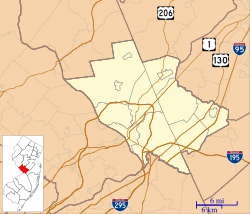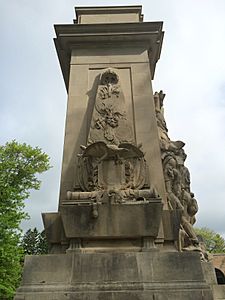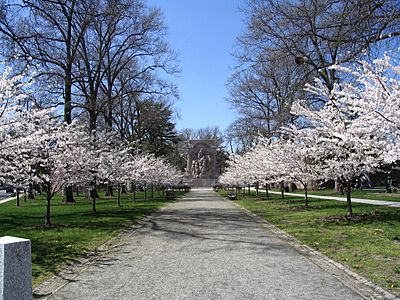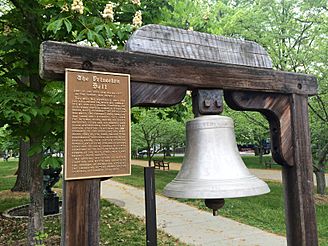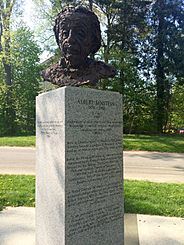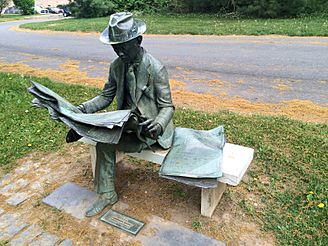Princeton Battle Monument facts for kids
Quick facts for kids Princeton Battle Monument |
|
|---|---|
| State of New Jersey | |
 |
|
| For The Battle of Princeton, 3 January 1777 | |
| Unveiled | 1922 |
| Location | |
| Designed by | Frederick MacMonnies, Thomas Hastings |
|
Here memory lingers to recall the guiding mind whose daring plan outflanked the foe and turned dismay to hope when Washington, with swift resolve, marched through the night to fight at dawn and venture all in one victorious battle for our freedom.
|
|
|
Princeton Battle Monument
|
|
|
U.S. Historic district
Contributing property |
|
| Part of | Princeton Historic District (ID75001143) |
| Added to NRHP | 27 June 1975 |
The Princeton Battle Monument is located in Princeton, New Jersey. It stands next to Morven and Princeton's town hall. This monument remembers the Battle of Princeton, which happened on January 3, 1777. It shows General George Washington leading his soldiers to victory. It also shows the death of General Hugh Mercer. The monument is 50 feet tall. Its design was inspired by carvings on the Arc de Triomphe in Paris. It was planned to be a grand sight at the end of Nassau Street. The monument and its park are part of the "City Beautiful movement." This movement aimed to make cities more beautiful.
Contents
History of the Monument
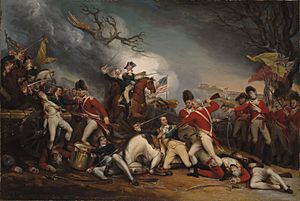
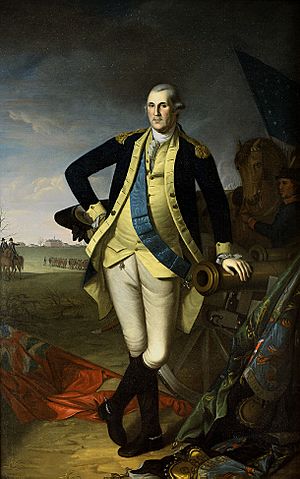
How the Monument Was Designed
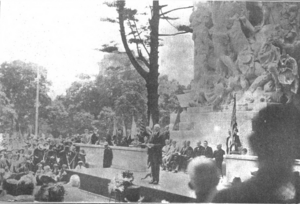
On June 8, 1906, the United States Congress decided to give $30,000. This money was for the Princeton Battle Monument Association. They wanted a monument to remember the Battle of Princeton. The association had to raise another $30,000 themselves.
The Princeton Battle Monument Association started in 1887. Important local people like Allan Marquand and Moses Taylor Pyne were part of it. By February 24, 1908, they had raised enough money. They then hired a famous sculptor named Frederick William MacMonnies. He was known for his "Beaux Arts" style. Thomas Hastings designed the architecture. He was from the well-known firm Carrère and Hastings.
It was hard to find the right place for the monument. At first, they thought about a triangular piece of land. This land was at the corner of Mercer and Nassau Streets. Buildings were cleared from this spot in 1913. But it was later used for the Princeton War Memorial.
In 1914, the Princeton Inn Company gave some land. The Inn was where the Princeton Borough Hall is now. They donated a 500-foot stretch of land. This land was between Bayard Lane and Morven. It went from Stockton Street north to a row of chestnut trees. This property was perfect. It had enough space for the monument and a park. It was also a very visible spot. The monument could be seen clearly from Nassau Street.
What the Monument Shows
The design by MacMonnies is a light-grey carving. It's called a bas-relief. George Washington on horseback is the main figure. He looks determined, refusing to give up. He inspires his tired soldiers to win the battle.
Below Washington, there is a young woman. She represents Liberty, or freedom. She wears a special hat called a Phrygian cap. She holds a banner to encourage the soldiers. Next to her are troopers and a drummer boy. They are from the Continental Army. At the very bottom, you can see the death of General Mercer. A local county was named after him.
The monument was first planned to be made of bronze and granite. But by 1918, they decided to use Indiana Limestone. This stone was carved right on the spot by the Piccirilli Brothers. The monument was finished in 1922. President Warren G. Harding officially opened it.
The opening celebration was special. There was a 21-gun salute. This was done by the Princeton University Field Artillery ROTC. A bishop named Paul Matthews gave a blessing. President Harding also received an honorary degree. It was a Doctor of Laws from Princeton University.
Lighting and Care
Lighting the monument at night was part of the first plan. But it took 85 years for the lights to be installed. This finally happened in 2007. The Princeton Parks Alliance raised money for it. Charles Stone designed the lighting.
The monument had been neglected for many years. It also had some unsuccessful repairs. So, in 2006 and 2007, it got a professional cleaning and repair. This was part of a New Jersey historic preservation project. Experts from Aegis Restauro, LLC and Farewell, Mills and Gatsch Architects did the work. In September 2007, the monument was rededicated. The new lights were turned on for the first time.
Words on the Monument
There are words carved on the back of the monument. Andrew Fleming West wrote them. They say:
Here memory lingers to recall the guiding mind,
Whose daring plan outflanked the foe and turned dismay to hope,
When Washington, with swift resolve, marched through the night,
To fight at dawn and venture all in one victorious battle for our freedom.
There is also a Latin phrase. It says:
Saecula Praetereunt Rapimur Nos Ultro Morantes Adsis Tu Patriae Saecula Qui Dirigis
The ages pass away. We, too, though lingering, are hurried on. O Thou who guides the ages, stay to guard our land.
Gallery
- The Monument and Park
-
The south side of the monument. The sides show the seal of the United States and the original thirteen colonies.
- Statues in the Park
-
The bell from the first USS Princeton. This was one of six ships named Princeton in the U.S. Navy. An explosion happened on this ship in 1844.
-
A copy of The Little Vintner of Colmar by Frédéric Auguste Bartholdi. It was given to Princeton in 1988 by its sister city, Colmar, France.
-
A statue of Albert Einstein's head. He lived in Princeton from 1933 until he died in 1955. He moved there after leaving Germany.
See also
 In Spanish: Monumento a la batalla de Princeton para niños
In Spanish: Monumento a la batalla de Princeton para niños


